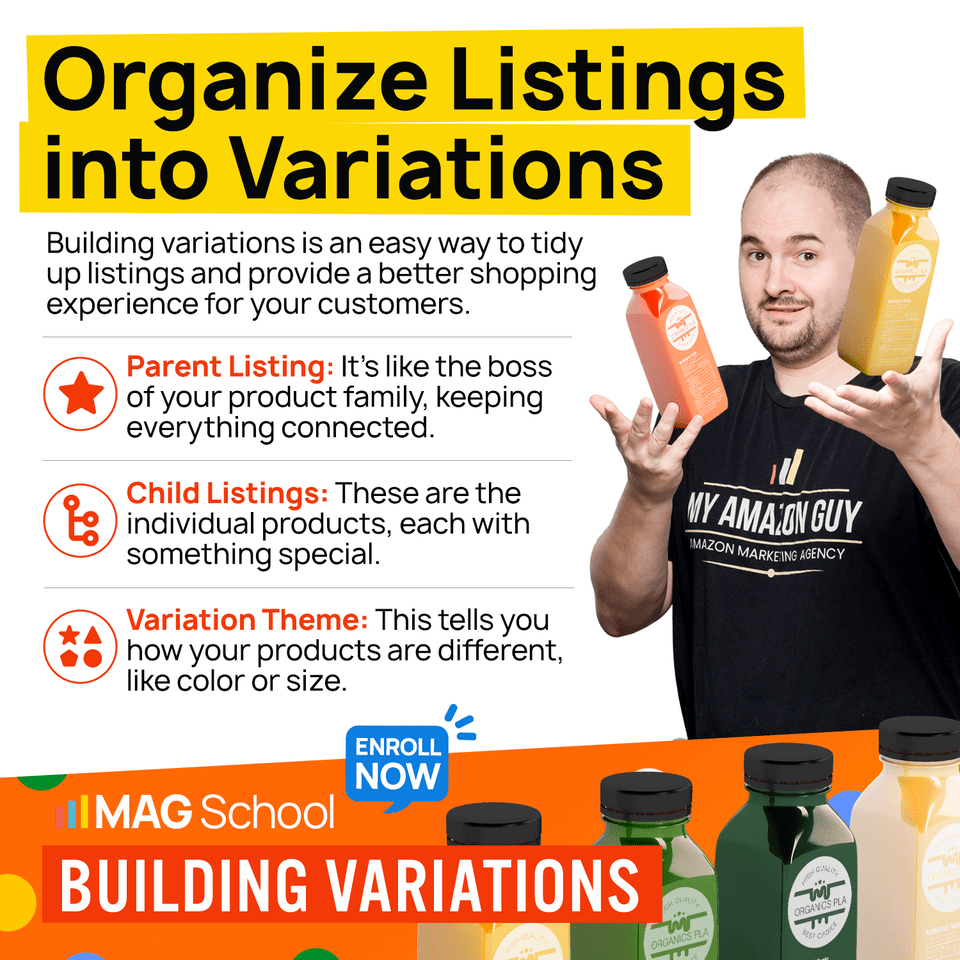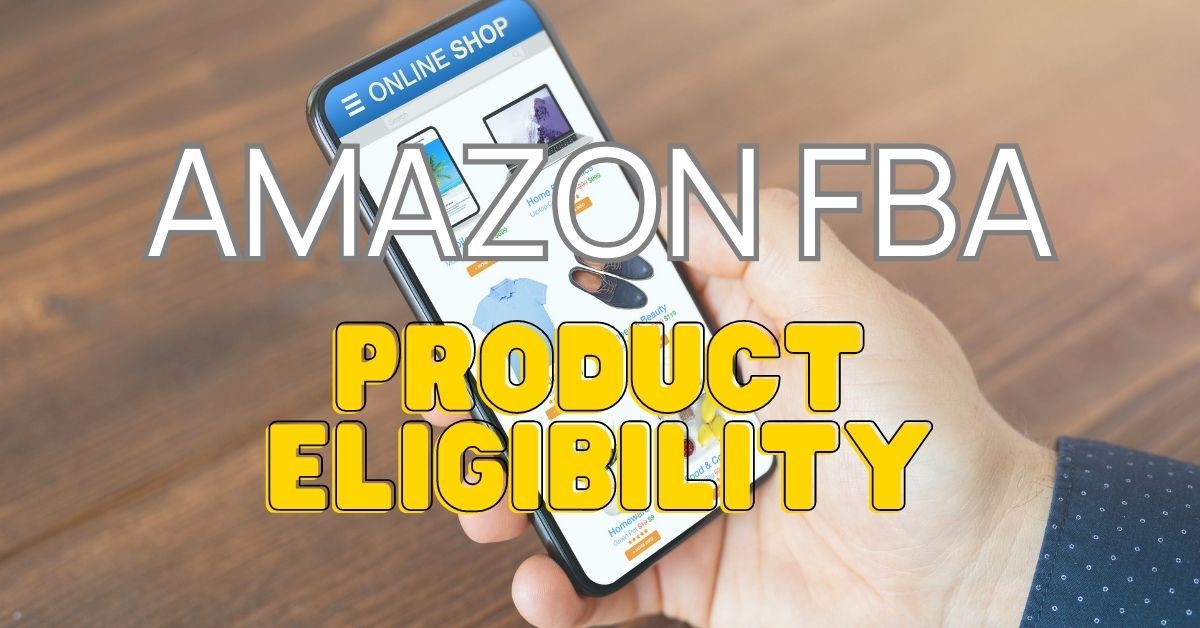Looking for a simple way to improve your Amazon listing? Try using Amazon Variation Relationships. But before you try it out, read this guide to implement it successfully!
Variation relationships also known as parent-child relationships, are one of the simplest ways to create an effective product listing. By grouping similar products together, sellers can significantly enhance customer experience, boost sales, and improve search rankings.
But how do you correctly implement variation listings? Don’t worry – our Amazon agency created this guide to provide an overview of Amazon parent-child relationships, covering their benefits, creation process, and optimization strategies to help you out.
What are Amazon Variation Relationships
Amazon Variation Relationships link related products (child listings) under one parent listing, which is why they are also called parent-child relationships. This structure allows customers to see all the variations available for a product, such as size, color, or style, all within a single page.
For instance, if you sell tumblers in different sizes and colors, you can list them under one parent tumbler product. This approach makes it easier for customers to see all the available versions of the same product and choose their preferred option.
Elements of a Variation Relationship
To better understand what a parent-child listing is, let’s break down the elements it consists of.
Parent Listing
The parent listing is the main product listing that groups all variations. It is a non-buyable entity used to relate the products and is the only listing shown in the Amazon search results.
This helps customers find all related variations of the product in one place.
Child Products
These are the individual variations of the parent product, such as different sizes or colors. Each child product must differ in at least one attribute and can have multiple variations as long as they fit within the same variation theme.
Variation Theme
The variation theme defines how the child products are different from each other, such as by style, color, or size. This theme ensures that all variations are logically grouped and easily comparable for the customer.

Here’s an example of how an Amazon listing with variation appears to customers:

Benefits of Adding Amazon Product Variations
Now that you know what a parent-child relationship is, let’s see how it can enhance your existing Amazon listing.
Better Sales Conversions
One of the biggest advantages of offering multiple options in one listing is that it encourages customers to make a purchase.
How? By providing customers with a wider range of options, you increase the likelihood of capturing their interest and driving conversions.
For instance, consider a shopper searching for a specific color or size of a product: having these options readily available within a single listing prevents them from abandoning their purchase and exploring other brands.
Moreover, you reduce the need for multiple product listings by grouping variations. This can simplify the decision-making process for customers when comparing and choosing products like clothing and kitchenware.
Increase Product Visibility
Combining your products into a single listing not only makes it easier for customers to find what they want, but it can also help your product stand out in search results. By grouping related items, you create a larger, more comprehensive product detail page, which tends to rank higher.
Moreover, grouping products is an effective strategy to improve the visibility of low-performing or new products. You can incorporate these types of products as new variations to an existing listing.
However, ensure to associate the new or less popular products with a related high-performing product.
Improve Product Ratings and Reviews
Another benefit of this strategy is the ability to make use of existing customer reviews.
It’s well-known that most shoppers rely heavily on reviews and feedback to make purchasing decisions. You can take advantage of this by associating new or low-performing products with a well-reviewed parent listing.
Customers are more likely to trust a new variation if it shares the positive reputation of its parent product.
When to Add Variation Relationships
While adding variations can improve your listings, it’s not suitable for every product. Use this strategy for items with specific attributes that can be effectively grouped.
For example, a tumbler available in different color variations would be perfect for this strategy. But a tumbler and a champagne glass, though both types of drinkware, would not be valid variations.
To know whether or not your products qualify for Amazon variation listings, ask yourself the following:
- Do the products serve the same purpose with only minor differences?
- Could the products share the same basic title?
- Are the differences between the products limited to specific attributes like color, size, or material?
- Would customers expect to find these products grouped together on a single product detail page?
If you answered yes to these questions, we encourage you to create a variation listing for your product.
How To Set Up Variations with Inventory Templates
Creating listing variations on Amazon Seller Central can help you effectively organize and present products with different attributes.
Here’s a step-by-step guide to set up variations using inventory templates:
Step 1: Prepare Your Products
Ensure the products you want to group together (child items) are already listed on Amazon.
Step 2: Download the Template
Get the correct product template from Amazon Seller Central.
Step 3: Fill in Product Details
Provide essential information for each product (parent and children) like SKU, title, brand, and ASIN.
Step 4: Create Parentage
- Designate one product as the parent (non-purchasable).
- Link child products to the parent using the Parent SKU column.
- Specify the variation theme (e.g., size, color).
Step 5: Review and Upload
Check all information for accuracy, then upload the template to Seller Central.
Step 6: Monitor and Adjust
Review the upload status and make any necessary corrections.
By following these steps, you’ve got the foundation for creating effective Amazon variation listings.
Tip: If you are still confused and want to learn how to set up product variations, enroll in MAG School Variation Course.
Best Practices in Implementing Amazon Variations
To optimize your Amazon product variation setup, especially for listings with numerous options, follow these best practices:
Avoid Complex Parentage Structures
For listings with numerous variations, such as different sizes and colors, avoid overly complex parentage structures.
If your product has multiple attributes such as style, size, and color, simplify your variation structure by creating separate parent listings for each attribute. For instance, group color variations under one parent listing and size variations under another.
Streamline Variation Selection
Simplify the customer experience by reducing the number of dropdown menus. If possible, consolidate options to minimize the steps customers need to take to select their preferred product.
For example, if the size selection is less crucial than color, consider listing color as the primary variation and size as a secondary option.
Prioritize the Most Popular Attributes
Focus on the attributes that drive the most sales.
If you have data indicating that certain sizes or colors are more popular, prioritize these in your variation setup. As an example, if one variation is a top seller, make it a primary option, and organize other variations around it.
Avoid Frequent UPC Changes
Avoid frequent changes to UPCs or merging listings, as these can negatively impact your product’s ranking and visibility.
Manage changes carefully to prevent issues like loss of ranking or incorrect listing merges.
Monitor and Adjust
Regularly review performance metrics such as sales to evaluate the effectiveness of your variation setup. If the conversion rate is below industry standards, consider simplifying complex parentage structures.
Analyze product performance to see if fewer options improve sales. You can use tools like Sellerboard and Seller Assistant to make the monitoring easier.
Simplifying Amazon Parentage: Video Case Study
Did you know that separating variations can provide a better shopping experience? Watch this video where I show how simplifying product variations can help increase conversion rates:
Key Points from the Video:
- Highlight Popular Attributes: Focus on the best-selling tensile strength (550).
- Simplify Structure: Separate size and color variations for clarity.
- Boost Conversion Rate: Simplification improved the conversion rate from 7% to 22%.
- Maintain Visibility: Avoid frequent UPC changes and listing merges.
Elevate Your Amazon Listings with Variation Relationships
Amazon Variation Relationships offer a strategic advantage by enhancing customers’ shopping experience, improving visibility, and making use of existing reviews. By following the best practices and understanding the elements of variation relationships, you can significantly boost your product’s performance on Amazon.
Ready to optimize your listings by mastering Amazon product variations? Contact our Amazon agency and get the help you need today!









